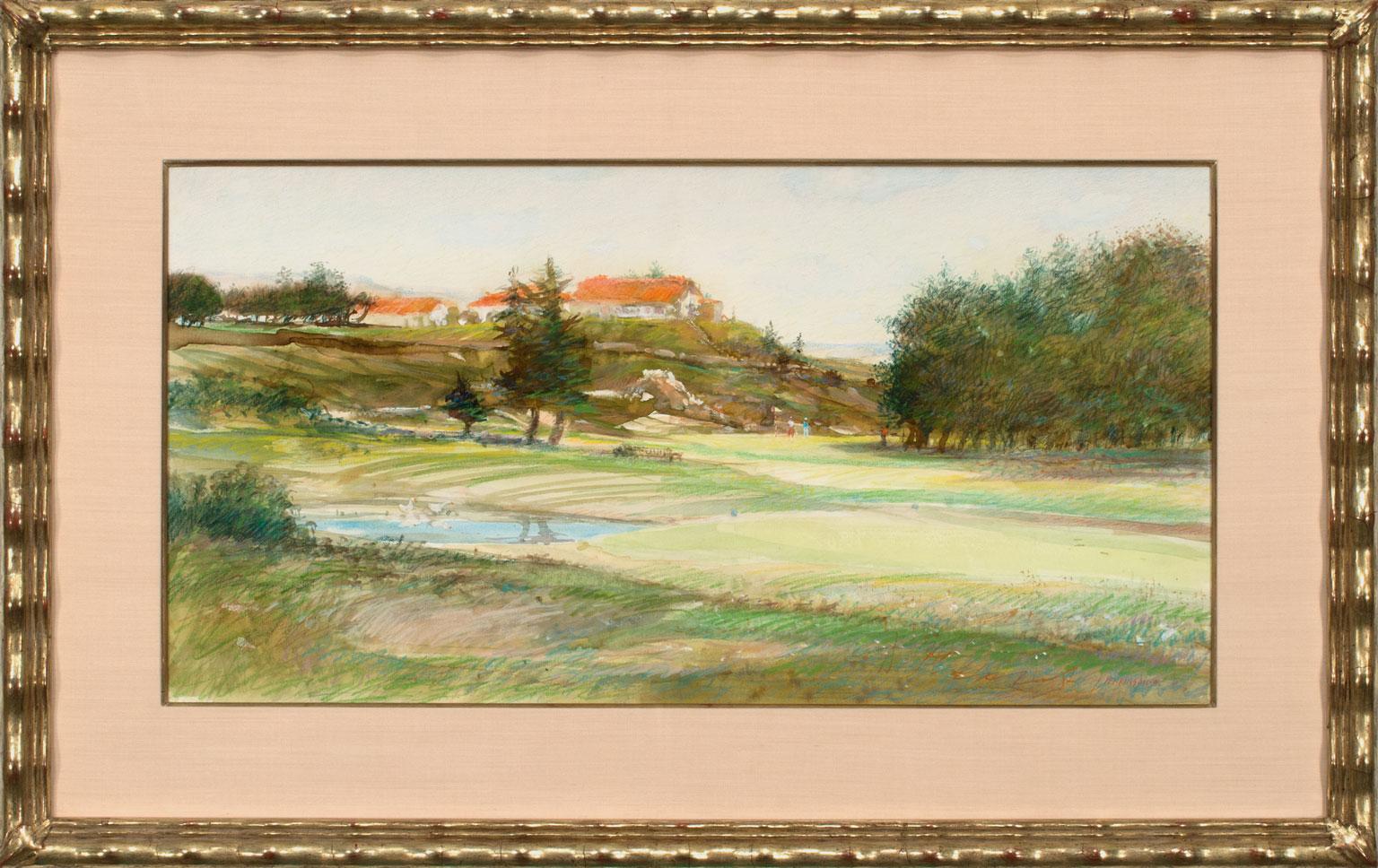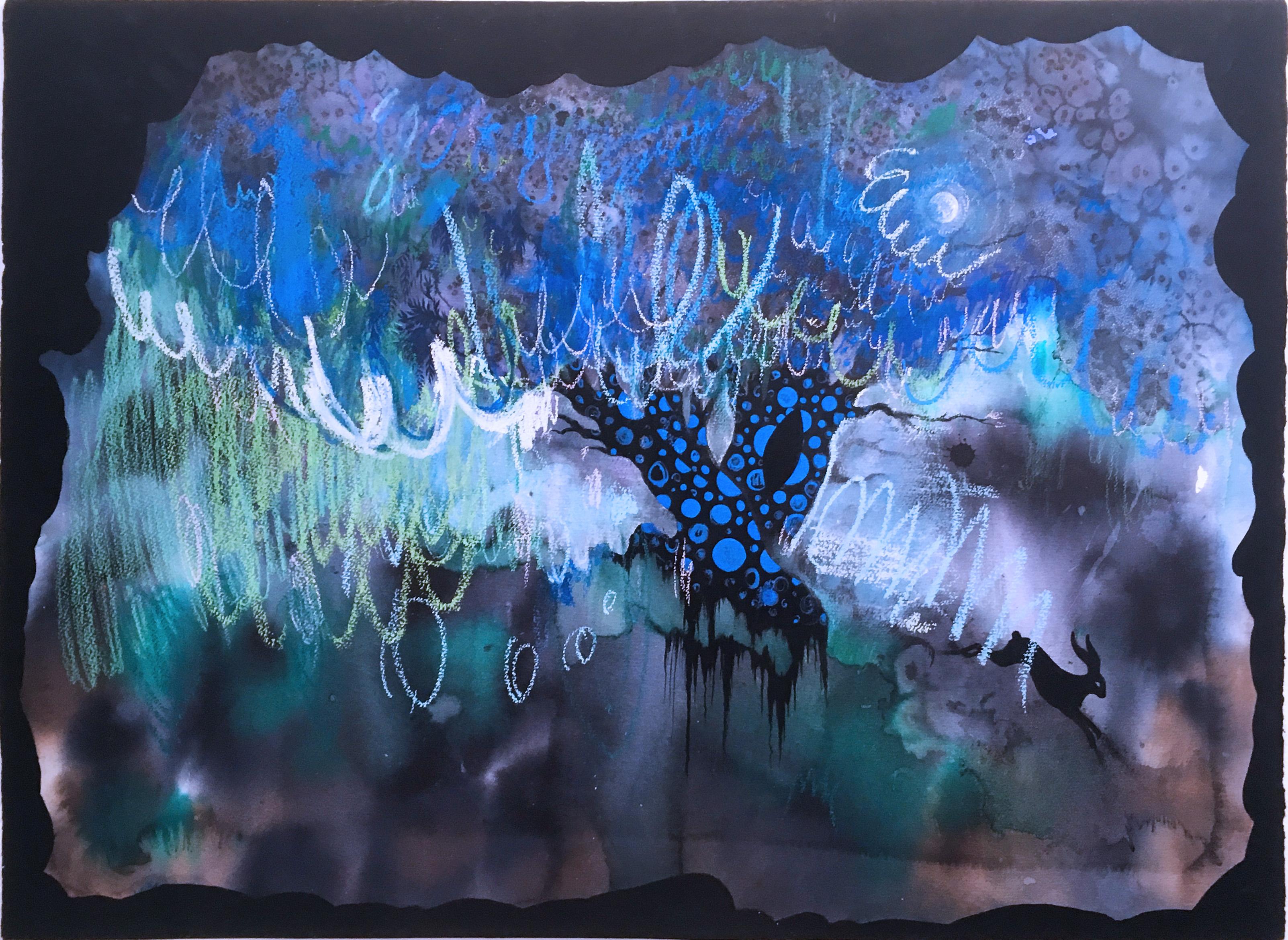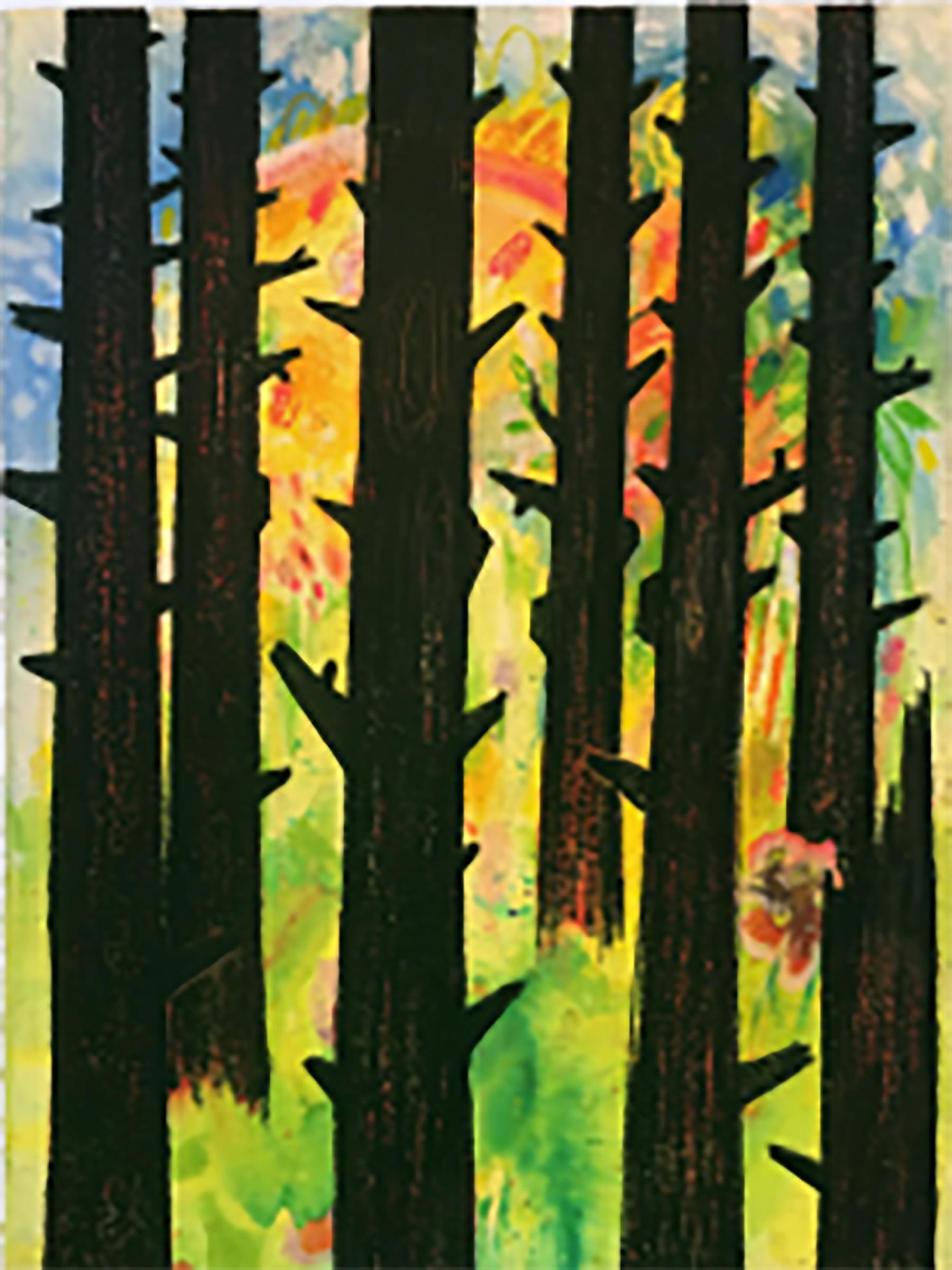Items Similar to "Andes Mountains Peru South America, " Joseph Yoakum, Black Folk Art Landscape
Want more images or videos?
Request additional images or videos from the seller
1 of 8
Joseph Yoakum"Andes Mountains Peru South America, " Joseph Yoakum, Black Folk Art Landscapecirca 1960s
circa 1960s
About the Item
Joseph Yoakum
Andes Mountains Peru So America, circa 1960s
Colored pencil and ballpoint pen on paper
7 1/4 x 10 1/2 inches
Provenance:
Karen Lennox Gallery, Chicago
Private Collection, South Dakota
Yoakum began drawing in the early 1960s. Most of his work consists of radiantly colored landscapes with mountains, water, trees, and winding roads in abstract and complex configurations. his period of greatest activity — 1965 to 1970 — when he usually made one drawing a day.
Yoakum maintained he had seen all the places represented in his drawings, a statement that may not be true in some instances. He traveled a great deal, beginning in his early teens when he ran away from home and became a circus handyman. Yoakum’s drawings can be considered memory images growing out of either actual or imagined experiences. All of his drawings have titles that grew longer and more specific over the years. He dated his works with a rubber stamp — an oddly impersonal, labor-saving device.
Although Joseph Yoakum gave vastly different accounts of his background, he was, throughout his life, classified as an African American. Sometimes Yoakum claimed that he was a full-blooded “Nava-joe” Indian, one of twelve or thirteen children born to a farmer on an Indian reservation in Window Rock, Arizona. At other times he insisted that he was of African-American descent. He described his mother as a strong woman who was a doctor and knowledgeable in the use of herbal medicines. Yoakum’s family moved to Kansas City, Missouri, during his early childhood. His father was employed briefly in the railroad yards prior to settling permanently on a farm in nearby Walnut Grove in southwest Missouri. Although Yoakum said that his formal schooling consisted of only three or four months, the character of the notations on his drawings suggests greater exposure to formal training.
The early years of Yoakum’s life were apparently nomadic. He claimed to have run away from home during his early teens to join a circus. He also claimed to have worked with Buffalo Bill before 1903, when he became the personal valet of John Ringling of the Ringling Brothers Circus. Between 1905 and 1910, Yoakum may have visited Europe, Russia, Mexico, the Middle East, China, Siberia, Canada, Central America, and South America. His first marriage occurred around 1910 and produced five children. He married again in 1929.
Yoakum served in the Unites States Army during World War I and was stationed at one time in France. The specific location and nature of his activities after his military discharge until his artistic career began in the early 1960s are uncertain. Yoakum said that he worked at a variety of jobs throughout the United States. In the early 1940s, he and his wife operated an ice cream parlor on Chicago’s South Side. By the late 1950s, however, Yoakum was widowed, retired, and living in a housing project for the elderly in Chicago. In 1966, Yoakum moved from the project to a storefront on the South Side. He lived there until he was hospitalized and placed in a nursing home in 1971; he died there the following year.
According to Yoakum, he was motivated to draw as the result of a dream around 1962. He described his process of working as a “spiritual enfoldment,” meaning that his imagery was revealed as he worked. Yoakum’s earliest drawings were done on small pieces of white or Manila paper with pen or pencil and little or no color. He graduated to larger pieces of paper and applied more color to his drawings as he drew with greater frequency.
Although Yoakum enjoyed doing celebrity-oriented portraits, the majority of his drawings are landscapes. In his hundreds of variations, real or imagined, mountains and water are the major themes. Between 1965 and 1970, Yoakum drew constantly and sometimes completed several pictures a day, often similar in theme, yet distinctly different in design. He kept an assortment of travel books, an atlas, and the Encyclopedia Britannica and took great pains to include inscriptions that name geographical details ranging from valleys to continents. Nonetheless, the scenes in Yoakum’s landscapes are generally not identifiable. Yoakum usually signed and dated his landscapes in the upper left corner. Occasionally he used a rubber stamp to indicate the date adding what he called a “touch of class.” Yoakum’s world was intensely private. His religious beliefs were rooted in the view that God and nature were the same thing. He expressed this belief in hundreds of drawings that are delicate, sensitive, and poetic in contrast to the bold, if not brash, character of most contemporary folk art.
- Creator:Joseph Yoakum (1890 - 1972, American)
- Creation Year:circa 1960s
- Dimensions:Height: 13.5 in (34.29 cm)Width: 17 in (43.18 cm)
- Medium:
- Movement & Style:
- Period:
- Condition:
- Gallery Location:New York, NY
- Reference Number:1stDibs: LU1841211574642
About the Seller
5.0
Platinum Seller
These expertly vetted sellers are 1stDibs' most experienced sellers and are rated highest by our customers.
Established in 2021
1stDibs seller since 2022
63 sales on 1stDibs
Typical response time: <1 hour
- ShippingRetrieving quote...Ships From: Larchmont, NY
- Return PolicyA return for this item may be initiated within 3 days of delivery.
More From This SellerView All
- "Tugboat at Dock, " Reginald Marsh, Modern WPA Industrial ShipBy Reginald MarshLocated in New York, NYReginald Marsh Tugboat at Dock, circa 1937 Signed lower right Watercolor and pencil on paper 13 3/4 x 20 inches Housed in a Lowy frame. Provenance: Sotheby'...Category
1930s Modern Landscape Paintings
MaterialsPaper, Watercolor, Pencil
- "Monhegan Island, Maine, " Edward Dufner, American Impressionism Landscape ViewBy Edward DufnerLocated in New York, NYEdward Dufner (1872 - 1957) Monhegan Island, Maine Watercolor on paper Sight 16 x 20 inches Signed lower right With a long-time career as an art teacher and painter of both 'light' and 'dark', Edward Dufner was one of the first students of the Buffalo Fine Arts Academy to earn an Albright Scholarship to study painting in New York. In Buffalo, he had exchanged odd job work for drawing lessons from architect Charles Sumner. He also earned money as an illustrator of a German-language newspaper, and in 1890 took lessons from George Bridgman at the Buffalo Fine Arts Academy. In 1893, using his scholarship, Dufner moved to Manhattan and enrolled at the Art Students League where he studied with Henry Siddons Mowbray, figure painter and muralist. He also did illustration work for Life, Harper's and Scribner's magazines. Five years later, in 1898, Dufner went to Paris where he studied at the Academy Julian with Jean-Paul Laurens and privately with James McNeill Whistler. Verification of this relationship, which has been debated by art scholars, comes from researcher Nancy Turk who located at the Smithsonian Institution two 1927 interviews given by Dufner. Turk wrote that Dufner "talks in detail about Whistler, about how he prepared his canvasas and about numerous pieces he painted. . . A great read, the interview puts to bed" the ongoing confusion about whether or not he studied with Whistler. During his time in France, Dufner summered in the south at Le Pouleu with artists Richard Emil Miller...Category
Early 20th Century American Impressionist Landscape Drawings and Waterco...
MaterialsPaper, Watercolor
- "Gray Morning" James MacMaster, Scottish Seascape, Marine Ship LandscapeBy James MacMasterLocated in New York, NYJames MacMaster Gray Morning Signed and titled lower left Watercolor on paper 10 1/4 x 14 inches Provenance: Private Collection, New JerseyCategory
Late 19th Century Landscape Paintings
MaterialsPaper, Watercolor
- "Irvine Harbour" James MacMaster, Scottish Seascape, Marine Ship PaintingBy James MacMasterLocated in New York, NYJames MacMaster Irvine Harbour Signed lower right Watercolor on paper 10 1/4 x 14 inches Provenance: Private Collection, New JerseyCategory
Late 19th Century Landscape Paintings
MaterialsPaper, Watercolor
- "Sheepshead, Brooklyn, Long Island" Oscar Bluemner, Modernist WatercolorBy Oscar BluemnerLocated in New York, NYOscar Bluemner Sheepshead, Long Island, 1907 Signed with the artist's conjoined initials "OB" and dated "4-30 - 5 - 30" / "Aug 3, 07" Watercolor on paper 6 x 10 inches Provenance: J...Category
Early 1900s American Modern Landscape Drawings and Watercolors
MaterialsPaper, Watercolor
- "Gloucester Harbor at Sunset, " John Hare, Cape Ann, New England Watercolor ViewLocated in New York, NYJohn Hare Gloucester Harbor at Sunset, Massachusetts Signed lower right Watercolor on paper 16 x 12 inches John Cuthbert Hare, 1908-1978, was a watercolorist who painted boats, seascapes and harbor scenes. He was primarily associated New England, especially Cape Cod, Massachusetts where he spent his summers from 1938 to 1965. However, he was in Florida where he was a member of the St. Augustine Art Association, and other locations on the East Coast. It is likely Hare was born in New York City. He first studied commercial art in Brooklyn at the Pratt Institute and also studied at the Art Students League in Manhattan. He worked for Hearst newspapers corporation, and in 1933 married. In the next few years, he and his wife traveled extensively, camping and painting and exhibiting his work in galleries. In 1935, they visited St. Augustine and an exhibition of his watercolors was held there in the old bank...Category
Mid-20th Century Impressionist Landscape Drawings and Watercolors
MaterialsPaper, Watercolor
You May Also Like
- Dark Night, 2020, watercolor, oil pastel, black, frame, landscape, fantasy, blueBy Shamona StokesLocated in Jersey City, NJWatercolor on paper, framed. Dark Night, 2020, watercolor, oil pastel, black, frame, landscape, fantasy, blue, creature. Framed and matted, frame size measures 24" x 35.75" x 1.25" ...Category
2010s Contemporary Landscape Paintings
MaterialsGouache, Color Pencil, Paper, Oil Pastel, Ink, Watercolor
- Anthemusa, 2020, watercolor, oil pastel, green, landscape, ink, fantasy, blueBy Shamona StokesLocated in Jersey City, NJAnthemusa, 2020, watercolor, oil pastel, green, landscape, ink, fantasy.Category
2010s Contemporary Landscape Paintings
MaterialsOil Pastel, Ink, Acrylic, Watercolor, Color Pencil, Graphite, Paper
- Hopeful Spring, 2020, watercolor, oil pastel, green, landscape, fantasy, treesBy Shamona StokesLocated in Jersey City, NJHopeful Spring, 2020, watercolor, oil pastel, green, landscape, fantasy, trees.Category
2010s Contemporary Landscape Paintings
MaterialsPaper, Oil Pastel, Ink, Acrylic, Watercolor, Color Pencil, Graphite
- "1940 - Number Nine" Original Mixed Media on Board by Tom Perkinson, FramedBy Tom PerkinsonLocated in Encino, CA"1940 - Number Nine" is an original mixed media on board by Tom Perkinson. His use of saturated violets, vivid yellows, and resplendent oranges pushes colo...Category
1980s Realist Landscape Paintings
MaterialsPastel, Ink, Mixed Media, Watercolor, Color Pencil
- "Plains Indian Camp" Lrg Original Mixed Media on Paper by Tom Perkinson, FramedBy Tom PerkinsonLocated in Encino, CA"Plains Indian Camp" is an original mixed media on paper by Tom Perkinson. His use of saturated violets, vivid yellows, and resplendent oranges pushes colo...Category
1980s Realist Landscape Paintings
MaterialsPastel, Color Pencil, Watercolor, Mixed Media, Ink
- "1940 - New Mexico Farmers" Orig. Mixed Media on Board by Tom Perkinson, FramedBy Tom PerkinsonLocated in Encino, CA"1940 - New Mexico Farmers" is an original mixed media on board by Tom Perkinson. His use of saturated violets, vivid yellows, and resplendent oranges pushes color to almost-otherwor...Category
1970s Realist Landscape Paintings
MaterialsPastel, Color Pencil, Watercolor, Mixed Media, Ink
Recently Viewed
View AllMore Ways To Browse
Vintage South America
Travel South America
Mountain Scenes Art
Middle East Art
Arizona Landscape Art
East African Art
Medicine Art
South American Landscape Paintings
American Express Vintage
Landscape Painting South France
Vintage Black Folk Art
French Military Art
Chinese Landscape Large
American Indian Art Painting
1950s Painting Landscape American
Arizona Landscape Painting
Run Away
Mountain Landscape France





